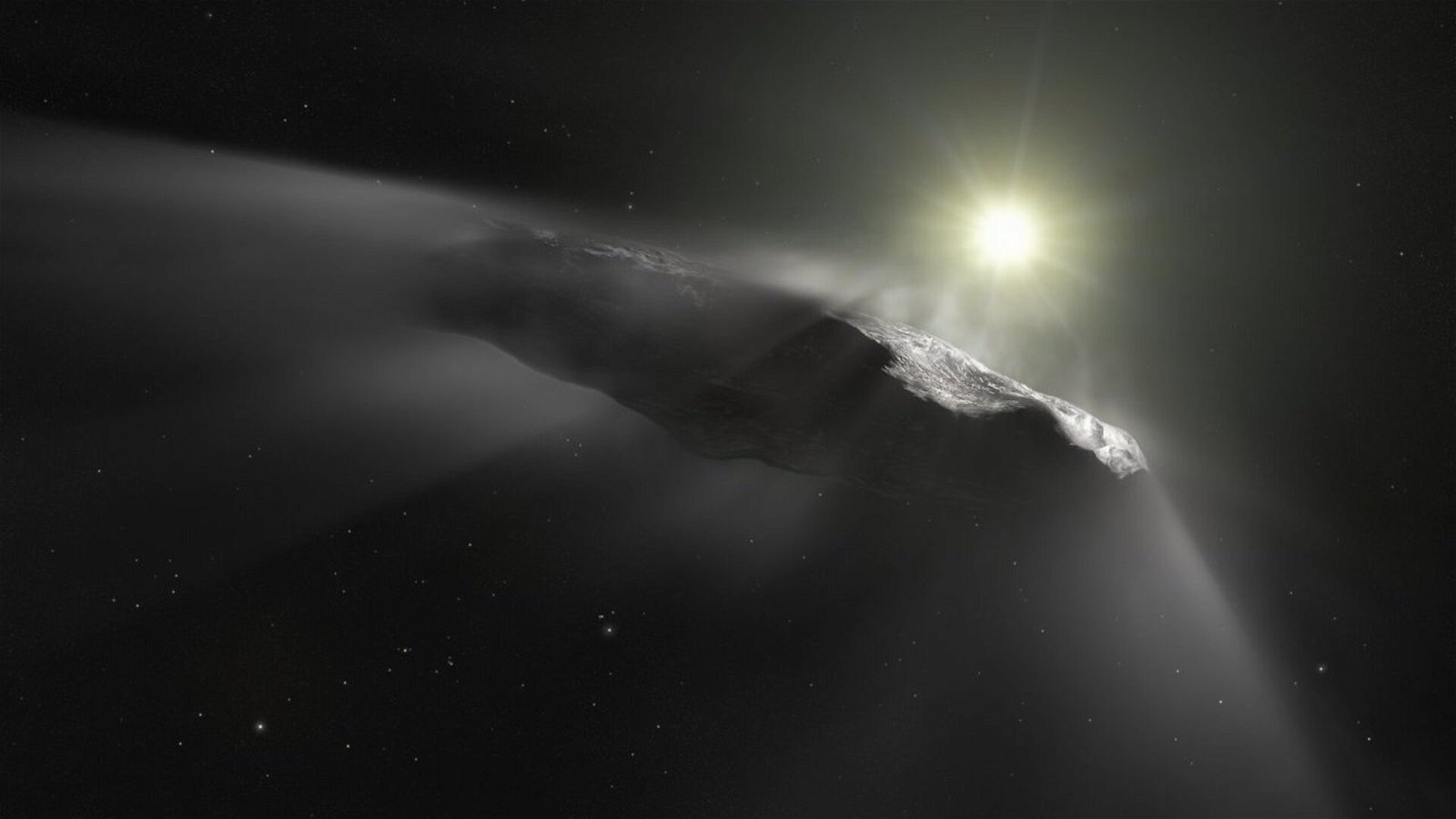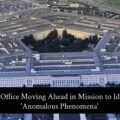

Welcome to this week’s installment of The Intelligence Brief… as the James Webb Space Telescope is gearing up for work by cooling down, this week we’ll be taking a look at why some astronomers think Webb may do more than just give us glimpses of distant alien worlds; it may even help us study a few interstellar visitors that make it to our neck of the cosmic woods. Items in our queue include 1) why Webb has to cool off a bit before it can get to work, 2) the role the telescope may play in the search for interstellar visitors, 3) how scientists are preparing for the arrival of the next ‘Oumuamua-type object, and 4) what this sort of discovery could mean in the years ahead.
Quote of the Week
“Everything is drawn inexorably toward the future.”
― Kip S. Thorne
Before we lift off this week, a few of the stories we’ve been covering at The Debrief include how the Biden Administration’s nominee to serve as watchdog for the DoD recently admitted unidentified aerial phenomena was “not an issue with which I am currently familiar,” but that he is “willing to look into that and take any action that’s appropriate.” Elsewhere, researchers have created a real-life transformer robot that can change from a driving vehicle to a flying one, and then back again; Chris Plain gives us the full scoop. Also, a group of astronomers recently authored a report about mysterious radio pulses repeating periodically every 18.18 minutes from a source in the sky labeled GLEAM-X. Is this a sign of alien intelligence? Dr. Avi Loeb thinks not, and tells us why.
And with that, it’s now time to see what all the buzz is about the James Webb Space Telescope, and why some NASA scientists are eager to see what it might help reveal about interstellar interlopers that could be lurking around in the space beyond our solar system.
The James Webb Space Telescope Just Needs to Chill Out… Literally.
Resting in orbit at its new home at Lagrange point 2, the James Webb Space Telescope’s time-consuming mirror alignment is presently underway, while the observatory’s various components continue to cool down to their optimal functional temperatures.
“While we have started the long process of aligning the telescope mirrors, almost all of the components on Webb’s cold side are still continuing to cool,” wrote Alise Fisher in a post at NASA’s Webb blog. The telescope and its cameras are protected from light irradiating directly from the Sun, as well as indirect light reflected back toward it from Earth, by Webb’s massive sunshield. Everything behind this shield is cooling down to what NASA identifies as a steady-state temperature, meaning that the functional components in question receive just enough heat that escapes through the sunshield to balance out the heat they are currently losing into space.
“We expect that the primary mirror will cool to below 50 kelvins,” Fisher added, “and the NIR instruments will reach about 40 kelvins.” For anyone who may not be up to speed on their temperature readings in kelvins, that means the primary mirror will eventually drop to a temperature of around -370 degrees Fahrenheit (-223 degrees Celsius), and the NIR (Near Infrared) components will be slightly cooler at close to -388 degrees Fahrenheit (-233 degrees Celsius).
Once Webb has reached its steady-state temperatures, the fun will begin as NASA and its partners begin training the telescope’s eye on distant regions of space. In fact, as Webb closes in on completing the alignment of its primary mirror with the help of its Near Infrared Camera (NIRCam) instrument, it has already produced its first images: one depicts a small scattering of 18 blurry points of starlight (they’re all actually the same star, which will be used to help focus and align the telescope), the other is a selfie (below) that Webb snapped and sent along to the folks at NASA’s Goddard Space Flight Center in Greenbelt, Maryland.


However, as Webb chills out and prepares to gear up for its mission, the folks at NASA are already buzzing about what could be one of the telescope’s major achievements: spotting the next mysterious interstellar interloper to come drifting toward our solar system.
Interstellar Visitors?
A recent NASA statement referred to the back-to-back discoveries of the mysterious 1I/’Oumuamua in 2017, followed by the appearance of the “rogue comet” 2I/Borisov the following year, as being among “the most exciting findings in planetary science in recent years”. In each instance, scientists were extremely limited in terms of the scope of observations that could be made of these objects, which has led to speculations about everything from oddly-shaped space rocks to the far-out (but not impossible) idea of extraterrestrial probes.
Enter Webb, which NASA says will be a game-changer the next time any interstellar mystery objects are spotted passing by our solar system.
Martin Cordiner is the principal investigator of what is called the Webb Target of Opportunity program, which will aim to employ the telescope’s advanced capabilities in gathering better data—and more of it—the next time an interstellar object passes near the Earth.


According to Cordiner, “The supreme sensitivity and power of Webb now present us with an unprecedented opportunity to investigate the chemical composition of these interstellar objects and find out so much more about their nature: where they come from, how they were made, and what they can tell us about the conditions present in their home systems.”
“The ability to study one of these and find out its composition — to really see material from around another planetary system close up — is truly an amazing thing,” Cordiner adds.
From Beyond: Preparing for the Next Otherworldly Arrival
Even if another interstellar object like ‘Oumuamua is spotted, it may take weeks—even months—to confirm that it is, in fact, of interstellar origin. Another determining factor involves whether the object’s orbit is hyperbolic, meaning that the cosmic visitor possesses enough speed to be able to escape the gravity of an object like our Sun.
Once these and other factors are confirmed, it will be the hope of astronomers like Martin Cordiner that the object will pass within the field of view of Webb, allowing further observations with the advanced observatory.
If these conditions allow for viewing the object, researchers will be able to tap Webb’s technological capabilities to observe light reflected off the prospective interstellar object in both near- and mid-infrared bands, which will provide clues about the object’s chemistry, as well as whether it leaves a trail of dust in its wake that may represent anything from pebbles it sheds as its surface is heated by the Sun, to microscopic particulates that might be invisible without Webb’s advanced imaging capabilities.
What This Means for Tomorrow
“Interstellar objects have not been observed before in these important near- and mid-infrared wavelength ranges,” reads a recent NASA statement outlining the agency’s plans to use Webb for gathering data on such an object in the future, should one appear.
According to the statement, NASA expresses that such observations may offer a defining moment not just for the James Webb Space Telescope, but for space study and exploration in general.
“[T]he possibilities for new discoveries are quite profound,” the release states. “With trillions and trillions of interstellar objects buzzing around the galaxy, the [Webb] team doesn’t know what they are going to find, but they know that it will be fascinating.”
That concludes this week’s installment of The Intelligence Brief. You can read past editions of The Intelligence Brief at our website, or if you found this installment online, don’t forget to subscribe and get future email editions from us here. Also, if you have a tip or other information you’d like to send along directly to me, you can email me at micah [@] thedebrief [dot] org, or Tweet at me @MicahHanks.


Here are the top stories we’re covering right now…
- Mysterious 18-minute Radio Pulses Are Not from “Little Green Men”
On January 26, 2022, a group of astronomers authored a report about mysterious radio pulses repeating periodically every 18.18 minutes from a source in the sky labeled GLEAM-X.
- Nominee for DOD Inspector General Pledges “Comprehensive Assessment” of Unidentified Aerial Phenomena if Confirmed
The Biden Administration’s nominee to serve as watchdog for the DoD admitted UAP was “not an issue with which I am currently familiar,” but that he is “willing to look into that and take any action that’s appropriate.”
- New Planet Found Orbiting Proxima Centauri
Scientists have detected signs of a third planet orbiting Proxima Centauri, which is Earth’s closest stellar neighbor.
- Many Prefer VR to In-Person Therapy, New Research Shows
New research indicates virtual reality mediated therapy could be better in some cases than one-on-one sessions.
- Apple is Using Artificial Intelligence and Music to Win the Music App Arms Race
Apple Inc. has recently acquired AI Music, a company using artificial intelligence and music to boost listener numbers.
- What Was Pilot Thomas Mantell Chasing When His Plane Crashed in 1948?
Balloon, UFO, or something else? Questions remain over one of the most famous–and tragic–UFO incidents of the 1940s
- This Real-Life Transformer Robot Can Drive, and Fly
Researchers have created a real-life transformer robot that can change from a driving vehicle to a flying one, and then back again.
- Fusion Reactor Breakthrough Readies Stage for ITER
Researchers have produced the largest energy output from any fusion reactor to date using the exact type of fuel used by the sun.
- Scientists May Have Found the Elusive Chemical Connection Between Food and Sex
From grapes and bananas to “popping cherries” and “buttering muffins,” food has long been associated with sex.
- Tech Talk Reviews HALO Infinite & The Pattern
In the latest edition of The Debrief’s Tech Talk, resident techno-nerds Mr. Stefan Gearhart (aka the camp counselor, because he was actually a camp counselor, because who would lie about that), and his trusted fellow host Dr. Josh Rutledge (who claims he would be the “leader of cheer” at any summer camp he worked, and who is also not a doctor) take a closer look at the Halo Infinite Campaign.
- Origins of Life on Earth May Be Extraterrestrial After All
Researchers have shown that amino acids can form peptides, the building blocks of life, in space, potentially explaining the origin of life.
- Birds with Big Brains Best at Resisting Climate Change
New research shows that birds with big brains are better at resisting climate change-induced shrinking than birds with smaller brains.
- A New Surgical Duct Tape Could Save Thousands of Lives
Engineers from MIT believe that they’ve created an effective surgical duct tape that can seal wounds and help the recovery process.
- Underwater Breathing Crops Could Help in the Fight Against World Hunger
Researchers at Nagoya University believe that plants have special root structures that can help them with underwater breathing.
- Your Office May Have Better Air Quality Than Your Home Does, New Research Says
Masks are more popular than ever thanks to the COVID-19 pandemic.
- Scientists Make Cannabis Without Growing the Plant Technology May Also Help Feed and Medicate Future Space Colonists
BioHarvest Sciences has announced the successful production of 22 pounds of fully viable cannabis biomass without actually growing the plant.
- China Reveals Its Newest Plans for Space Dominance
In a newly issued white paper, China has charted out the next five years of its space program’s ambitious goals.
- Science Just Validated These Mask Hacks That Work for Better Comfort
Social media has propagated several mask hacks. Now, a new study from the University of Cambridge has tested them to see if they work.
